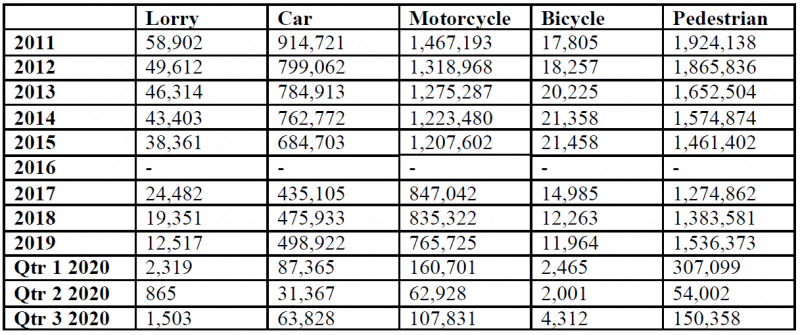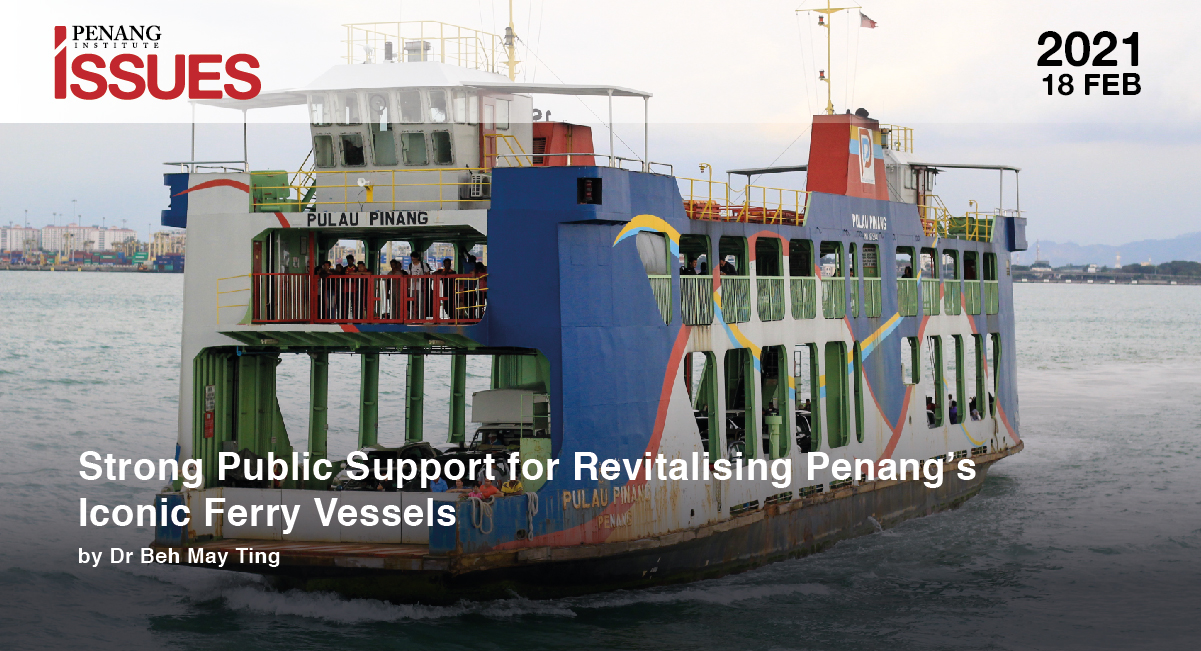EXECUTIVE SUMMARY
- This paper considers the development of Penang’s ferry services, and makes suggestions on the utilisation of the old vessels, after their planned retirement in mid-2022. It also aims to inform decision-makers in designing adequate services that respond to real needs felt by the public.
- Issues of high maintenance, safety, sustainability, and low number of users have been cited as reasons behind the decision of retiring the 47-year-old ferry vessels.
- Based on a state-wide survey conducted by Penang Institute, 83.7% of 111 respondents call for the iconic vessels to retain its original function of transporting four-wheeler vehicles, two-wheeler vehicles, and pedestrians across the Penang Channel, in addition to the new catamarans. However, this should come with improvement in the service in terms of user-friendliness, particularly in punctuality, ticket-purchase system, cleanliness, and wheel-chair access.
- The Penang State Government currently owns one ferry vessel while the rest of the fleet belongs to the Penang Port Commission. The different managements and underlying political standpoints will likely result in varied functions for the ferry vessels.
- The state is recommended to improve efficiency and to take preventive maintenance measures, should it decide to maintain the transportation function of the sole double-decker ferry vessel it owns.
Introduction
Beginning 1 January 2021, Penang’s 47-year-old ferry vessels which used to transport both pedestrians and vehicles between the island and the mainland have been replaced by two fast boats carrying foot passengers between Swettenham Pier on the island and the Sultan Abdul Halim Ferry Terminal on the mainland. From 6.30am to 11pm, there is a trip every 20 to 30 minutes, making up 27 round trips per day. This is the interim solution put in place until 30 June 2022 while the existing ferry terminals are being upgraded to allow water buses and vehicular ferries for two-wheeler vehicles to dock (Liew, 2021). On 1 July 2022, the speedboat service will be replaced by catamarans and vehicle transporters. The catamarans will have a maximum capacity of 200 passengers and is expected to make 40 trips a day. Catamarans are easy to maintain, compared to the old ferries. In fact, the cost of repairing a ferry can reach up to RM2.2 million, involving difficulties in acquiring spare parts which need to be imported from Germany and Sweden (Bernama, 2020).
The remaining old ferries, Pulau Angsa and Pulau Talang-Talang, are still in service, but only to ferry two-wheelers. They will be retired once the existing ferry terminals are upgraded. Other commuters using four-wheeler vehicles will have to use either of the two Penang Bridges, as they can no longer board the ferries (Lo, 2021). The Penang Port Commission has made resolutions not to scrap the old ferries but to repurpose them as heritage references. While the Penang Public Transport Users Association (PETUA) lauds this resolution, it has also raised its concerns that the remaining old ferries should be preserved for their original function as a means of transport albeit now for recreational purposes. This resolution is preferred instead of the old ferry vessels being treated merely as floating museums and restaurants. (Liew, 2020).
Gifting of one ferry vessel to the Penang State Government
On 27 January 2021, the Penang Port Commission (PPC) gifted one of the iconic ferry vessels to the Penang State Government. The fate of this particular vessel is yet to be determined (Mok, 2021).
Meanwhile, a Request for Proposal to lease its ferry vessels will be advertised by PPC soon. Bidders may lease the vessels either as floating museums or tourist restaurants. The term of the lease is for 10 years, with the option to extend for another five (Mok, 2021).
Public Opinion on the utilisation of the old ferry vessels
Below are data based on 111 responses from a survey entitled ‘Penang Ferry Service Survey’, which was conducted between 11 January 2021 and 10 February 2021 on Penang Institute’s social media sites such as Facebook, Twitter, and Instagram. The survey was also shared among users on their own social media pages. The respondents are born and/or are residing in Penang and/or identify as a Penangite. It was designed for respondents to only answer questions they are comfortable with, for the purpose of gauging the importance they attach to the issue, and/or their interest in different aspects of the issue.
In general, a majority of the respondents call for the preservation of at least one iconic ferry vessel to retain its original function of mass transporting four-wheeler vehicles, two-wheeler vehicles, and pedestrians, even after the set date of the retirement of the ferries on 1 July 2022. However, much improvement needs to be made to the ferries and to the service in order to keep it an attractive mode of transportation across the Penang Channel. Recurring comments from the survey suggest the need for punctuality of ferry departures, cleanliness, and improvements on user-friendliness, for example in terms of digitalising ticket purchase and making the service more accessible for wheelchair users.
While it is understood that upkeeping the iconic ferries is costly, it is nevertheless worth it to preserve them as closely to their original function as possible, as they are a part of Penang’s identity and cultural heritage. We may look at the example of Hong Kong’s Star Ferry for inspiration on keeping iconic ferries relevant and sustainable.
1. Preservation of old ferry vessels as mass public transport
As indicated in the chart below, 79.3% of the 111 respondents feel that the old ferry vessels should not be completely retired as a means of mass public transport after 30 June 2022, which is the current plan (Figure 1). 83.7% of the respondents feel that at least one of the ferry vessels should be kept in its original function, i.e. to serve pedestrians, two-wheeler vehicles, and four-wheeler vehicles (Figure 2). This is most probably due to the idea that the ferry vessels are iconic of Penang, as agreed to by 95.4% of 110 responses (Figure 3). In addition, with the Covid-19 pandemic, respondents voice preference for using the old ferries due to their open-air nature over the temporary speedboats used for pedestrians. The speedboats have less air ventilation and offer less chances of social distancing as compared to the old ferries.
Figure 1: Percentage of agreement to the complete retirement of iconic ferries as transporters after 30 June 2022.

Figure 2: Percentage of agreement to having at least one iconic ferry vessel remaining in service (serving pedestrians, two-wheeler vehicles, and four-wheeler vehicles), after the upgrade of the ferry terminals.

Figure 3: Percentage of agreement that the old Penang ferry vessels are iconic to Penang’s identity.

2. Areas for improvement if ferries remain as a mode of mass transportation
There has no doubt been a general downward trend in the total number of users of the ferry services from 2011 onwards. While the number of cars and pedestrians using the ferry to cross the Penang Channel increased slightly from 2017 to 2019, the number of lorries, motorcycles, and bicycles decreased within the same period (Table 1). This indicates that users are resorting to the two Penang Bridges to cross the Penang Channel. According to the survey, various changes are needed to improve the ferry services, and thus to increase the number of users.
Table 1: Number of users by modes of transport which used the Penang Ferry service, 2017-2020 (3rd Quarter)

- Punctuality of departure times
One of the most common comments from the survey on improving the ferry services is the need for punctuality of departure times. While 84.7% of 111 respondents agree that they do not mind the slow ride on the ferries (Figure 4), the long waiting time at ferry terminals discourages many users from using the ferry service. A study on ferry users in Norway shows that travellers’ time spent on ferry terminals is substantially wasted compared to when when they use other modes of transportation (Small, 2012). For travellers, the more trips a public transport is able to make, the better it is (Jørgensen and Solvoll, 2018). This is because waiting time is significantly reduced (Hanssen et.al., 2020). Prior to 1 January 2021, Penang ferry services operated at 40-minute intervals (Mok, 2020). In addition, there is a need for better clarity and accuracy in displaying departure times of the ferries. While there are TV screens at the ferry terminals showing the departure times, the information displayed were usually inaccurate. Clear live updates on departure times for upcoming rides are needed, and possibly via online social media platforms too.
Figure 4: Percentage of respondents who do not mind the slow ride on the Penang ferries

- Integration with public transport system
Another issue raised by survey respondents was the need for synchronisation with other means of mass public transports, especially for connecting commuters to the trains (KTM Butterworth at Penang Sentral) and public and/ or express busses. The poor connectivity and integration of the ferry service with the public transport service inconvenience travelers.
- Digitalising ticket purchase system
Digitalising the ticketing system into a cashless system will allow users to purchase tickets beforehand, tap through and board the ferry seamlessly. This would reduce crowding and ease the onboarding process as travelers are usually in a rush when the ferry is about to depart. Otherwise, allowing passengers to tap through with their Touch ‘n Go cards, debit cards, or prepaid IC would also make ticket purchase much more convenient, as less and less people carry cash with them today.
- Accessibility for wheelchair-users and travelers with luggage
In line with the Penang2030 vision of increasing livability of senior citizens and special needs groups, user-friendliness needs to be enhanced at ferry terminals as well as on the ferries. Ramps for wheelchairs and luggage are crucial in enabling users with different needs to travel on the ferries. Travelers on the ferries are often also connecting travelers to train and bus services, who undoubtedly have luggage with them. The lack of ramps, elevators and escalators inconveniences users.
- Cleanliness
The façade of the ferries generally has a greasy look, which is rather unsightly. Having a cleaner, and thus more aesthetically-pleasing ferry would offer passengers better comfort and give the state a better image.
- Upgrade to environmentally sustainable options in ferry engine
Engine issues are often the cause of disruption to the ferry services. On top of that, the fumes the ferries produce cause pollution. It would be ideal to upgrade the ferries with low-emission technologies to be more environmentally-friendly.
3. Suggestions on diversifying function of ferries to keep it relevant for today’s users
While Penang’s ferries are unique to the state, it would be wise to learn from other iconic ferry services in the region to understand why and how these are kept sustainable, practical, and relevant. One such ferry service is Hong Kong’s Star Ferry service. Diversifying the function of the iconic ferries, for example, would allow them to continue being relevant, popular, and possibly create a source of revenue.
I. Ferry hire
Apart from being a mode of mass public transport, Hong Kong’s Star Ferries are available for hire for events like wedding cocktails, private parties, corporate events, and new product launches. It is a sought-after venue due to the close-up view it offers of Victoria Harbour. This could be replicated with Penang’s ferries with the right expertise, manpower, and management.
II. Water tours
In Hong Kong, a designated environmentally-friendly ferry which runs a distinctive tourist service not restricted to plying within Victoria Harbour but beyond the harbour brings tourists and locals to different destinations in Hong Kong’s waters via an unprecedented route. Similarly, this can also be replicated with Penang’s ferry service by plying beyond the George Town-Butterworth route, to head north towards Straits Quay or south towards the first Penang Bridge. This would potentially be an attraction for tourists and locals.
Conclusion
While it remains to be seen if the old ferry vessels will be permanently anchored and solely used for heritage and/ or tourism purposes, or if any of the vessels will continue to function as a mode of transportation, it is clear that they represent a part of Penang’s identity, and should continue to closely mirror its original function. With one ferry vessel belonging to the Penang State Government and the rest of the fleet belonging to PPC, there will undoubtedly be differences in opinions and management of the ferries. It is understandable that expensive and frequent maintenance, and insufficient volume of commuters drove the decision to retire the existing 47-year-old double-decker ferries.
Be that as it may, the survey shows how Penangites view the ferry service and it is clear that it would be a shame to anchor the iconic ferries permanently. Ideally, the old ferries should be kept running concurrently with the new catamarans and vehicle transporters when they arrive in mid-2022.
For list of references, kindly download the document to view.
Editor: Ooi Kee Beng
Editorial Team: Sheryl Teoh, Alexander Fernandez, Tan Lii Inn and Nur Fitriah (Designer)
You might also like:
![Stuck in Traffic: Why Malaysia Does Not Have a Motorcycle Ride-hailing Sector]()
Stuck in Traffic: Why Malaysia Does Not Have a Motorcycle Ride-hailing Sector
![Need for Speed: Survey Findings on Penang Internet Connectivity]()
Need for Speed: Survey Findings on Penang Internet Connectivity
![How Tools from the Discipline of History Can Improve Public Policymaking]()
How Tools from the Discipline of History Can Improve Public Policymaking
![Realising Blue Economy Benefits in Penang]()
Realising Blue Economy Benefits in Penang
![[Rapporteur Notes] Penang Economic Summit 2022: The Post-Pandemic Economic Reset]()
[Rapporteur Notes] Penang Economic Summit 2022: The Post-Pandemic Economic Reset






![[Rapporteur Notes] Penang Economic Summit 2022: The Post-Pandemic Economic Reset](https://penanginstitute.org/wp-content/uploads/2022/12/thumbnail-1-150x150.jpg)
